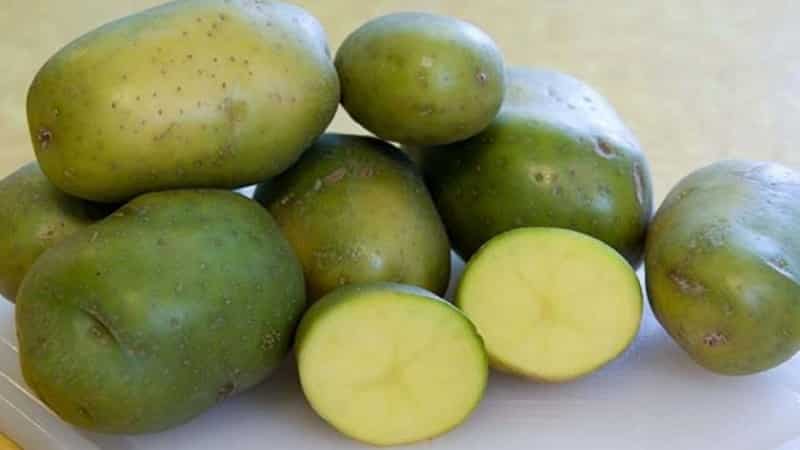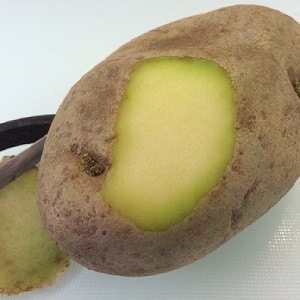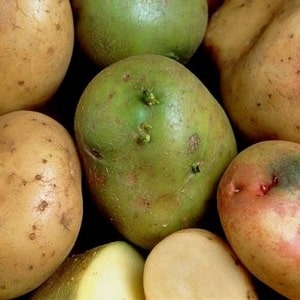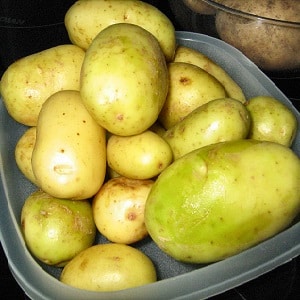Is it possible to eat green potatoes, is it dangerous for the human body and why?
In addition to vitamins, micro- and macroelements useful for the human body, potatoes contain solanine. This is an organic compound, a poisonous glycoside, which is present in any part of the plant - in leaves, fruits, tubers, stems. For potatoes, it serves as a natural protection against damage by bacteria and some types of insects, and is toxic to humans. The highest concentration of solanine is in unripe green fruits.
What is solanine, what is its toxicity and harm to the body, what are the symptoms of poisoning and first aid, why do potatoes turn green in the light, can they be eaten, why are green potatoes dangerous - read the article.
Why do potatoes turn green when stored in light?
There is little solanine in mature potatoes - 0.005%, but It accumulates during long-term storage. The deciding factors are temperature and sunlight.
So why do potatoes turn green in the light? The fact is that chlorophyll is present in all parts of the plant, including tubers. This is a green pigment responsible for the green color and the process of photosynthesis, during which organic substances are formed from carbon dioxide and water under the influence of sunlight in the plant body.
During evolution, the above-ground part of the plant became green to better capture the necessary sunlight.Tubers located underground are not initially green, since the sun's rays do not penetrate into the soil. Also, tubers do not turn green in artificial light, because the process of photosynthesis is possible only under the sun.

What does the green tint mean?
The green color of potato tubers indicates that they did not have time to ripen or during storage the fruits were not protected from the sun.
In addition, green tubers mean a high concentration of poisonous solanine.
Is it possible to eat green potatoes?
For those who are interested in the question of whether it is possible to eat green potatoes, we answer that green potato tubers are inedible. Heat treatment (boiling, stewing, frying) does not destroy solanine. If ordinary green potato fruits contain 0.005% solanine, then green potatoes contain 0.1%, and tops generally contain 0.25%. In addition, such potatoes have an unpleasant bitter taste and are slightly astringent in the mouth.
What if you cut off the green part?
 Experts strongly advise against eating green potatoes, but... at the same time, they say that after removing the surface of the peel to a depth of 1 cm and prolonged heat treatment, the fruits remain edible. However, when planting a quarter of a tuber, eating it is strictly contraindicated, as is feeding it to animals. Root crops must be destroyed or used as planting material.
Experts strongly advise against eating green potatoes, but... at the same time, they say that after removing the surface of the peel to a depth of 1 cm and prolonged heat treatment, the fruits remain edible. However, when planting a quarter of a tuber, eating it is strictly contraindicated, as is feeding it to animals. Root crops must be destroyed or used as planting material.
Solanine successfully resists fungal microorganisms and harmful insects. Therefore, green tubers are high-quality planting material. Such root crops give a higher yield, 20% higher compared to ordinary fruits. Agronomists even recommend keeping the planting tubers in the sun for several days until the underground shoots turn green and grow.
Interesting things about potatoes:
How dangerous are potatoes and can you get poisoned by them?
What happens if you eat green potatoes
Why are green potatoes dangerous? A small portion of unripe potato tubers does not threaten human health and life, especially if the root vegetables have been cooked before cooking. Solanine poisoning is possible after eating several kilograms of unpeeled green potatoes. without heat treatment. Potatoes, 100 g of which contain 40 g of solanine, are considered life-threatening.
What is solanine and why is it harmful?
Solanine is a poisonous glycoside produced in plants of the nightshade family. and is found in any part of the plant. As for potatoes, there is especially a lot of solanine in the peel and sprouts.
In regular potato roots the level of solanine is 0.005%, in green tubers it is much higher. Upon reaching maturity, the vegetable becomes whitish, yellowish or reddish depending on the variety, and the solanine content decreases. And the fruits can be eaten after heat treatment.
Attention! Solanine is toxic to humans even in small doses. It causes stimulation and depression of the nervous system, then depression and destruction of red blood cells. High doses of the alkaloid can cause fever, convulsions, and dehydration, which can be fatal for a weakened body.
Signs of solanine poisoning
 Due to the accumulation of toxic substances in the body beyond the norm, intoxication occurs. When taking a small dose, there is a latent period, during which a person feels satisfactory.
Due to the accumulation of toxic substances in the body beyond the norm, intoxication occurs. When taking a small dose, there is a latent period, during which a person feels satisfactory.
The asymptomatic period lasts on average 2-6 hours, sometimes shortened to 30-60 minutes or lasts about 24 hours. A mild form of poisoning is manifested by nausea, vomiting, stomach pain, headache and dizziness, and diarrhea. The frequency of stool can reach up to 10 times a day.
In case of moderate poisoning, the symptoms are similar, only brighter. The victim complains of lethargy, muscle pain, general malaise, decreased endurance and performance. Loss of fluid through vomiting and stool has an adverse effect on the condition of the skin: it becomes dry, flabby, and facial features become sharper.
In severe forms, typical signs of poisoning are pronounced. The central nervous system is often affected, which is manifested by hallucinations, speech and vision disorders, euphoria, convulsions, and coma. When exposed to the cardiovascular system, arrhythmia, tachycardia are observed, and blood pressure drops. As a result of cardiac dysfunction, coma or death may occur.
First aid for solanine poisoning
A set of emergency medical measures begins with gastric lavage to clean water and performing an enema to remove toxic substances. For the same purpose, enterosorbents are prescribed, which have an antidiarrheal effect, absorb and remove glycosides and other compounds from the body.
If treatment and preventive measures do not help, symptoms worsen, and general health worsens, call an ambulance or take the victim to the hospital.
To prevent dehydration, replenish fluid loss. They drink sweet tea, saline solution, still mineral water.For moderate forms of poisoning, parenteral rehydration therapy is carried out - the necessary solutions are injected into a vein through a dropper.
Take note:
Precautionary measures
 The best way to prevent: grow potatoes in guaranteed safe conditions, without nitrates and other toxic substances. If you buy potatoes, pay attention to the appearance of the fruit and storage conditions. Don't buy the first new potatoes because there is a chance that they will be overloaded with nitrates.
The best way to prevent: grow potatoes in guaranteed safe conditions, without nitrates and other toxic substances. If you buy potatoes, pay attention to the appearance of the fruit and storage conditions. Don't buy the first new potatoes because there is a chance that they will be overloaded with nitrates.
Pay attention to the peel and integrity of the tubers. High-quality potatoes have a dense skin that is difficult to damage with a fingernail; they do not have black spots or signs of damage by insects.
It is not advisable to eat green potatoes, but it is possible after removing a thick layer of peel and prolonged heat treatment. You need to know moderation in everything: even in a healthy person, large portions of a high-quality product can provoke negative manifestations - constipation, allergies, exacerbation of type 2 and 3 diabetes.
Advice. Experts recommend, if possible, choosing medium-sized fruits, since large fruits contain salts and esters of nitric acid, which are toxic to humans, and small ones have not yet had time to grow and ripen.
Rules for storing potatoes
The accumulation of solanine and sugar - glucose, fructose, sucrose and maltose - in potato tubers can be regulated by changing the temperature and humidity of the air, avoiding direct exposure to sunlight. Optimal conditions for storing potatoes: temperature from +2 to +5°C, air humidity - 85-90%. Under such conditions, more sugar is consumed than produced.At temperatures above +5°C, tubers begin to develop and axillary buds sprout on them. When the temperature drops to 0°C, starch is converted into sugar, and maltose accumulates in the fruits.
To store crops at home, it is ideal to use a cellar or vegetable storage. The room must maintain constant conditions - darkening, low temperature, fresh air.

Preparation for storing potatoes begins immediately after harvesting. The tubers ripen in August-September; during this period it is necessary to remove the root crops. If potatoes are in the ground for a long time, they begin to absorb excess moisture, which adversely affects the taste and reduces their shelf life.
You cannot wash potato tubers before storing them in the cellar.. Initially, they must be cleaned of dirt by hand, laid out in a well-ventilated area or under a canopy so that the root vegetables dry well.
Attention! Avoid direct exposure to sunlight.
Further you need to sort the potatoes according to the size of the tubers, remove damaged fruits. If you grow your own potatoes, immediately separate part of the crop for planting. Carefully pour the potatoes into bags so as not to damage the tubers, and lower them into the cellar. In the cellar, it is better to store vegetables in wooden boxes or pallets. If you scatter potatoes on the floor, there is a high risk of losing part of the harvest.
Containers must have holes for free air circulation, you cannot place them on the floor or close to the walls. Before planting the crop, it is advisable to treat the boxes with an antiseptic and dry them well.To protect the crop from damage by insects, vegetable growers recommend sprinkling the crop with ash, chalk, and laying out bags of wormwood, elderberry or rowan leaves.
Periodically It is recommended to check the condition of the potatoes, remove damaged or rotten tubers.
Advice. To further protect the potatoes from the cold, you can cover them with felt and sprinkle sawdust or straw on top. It is ideal to store beets on top of potatoes. It not only helps to retain heat, but also absorbs moisture well.

How to prevent potatoes from turning green
It is possible to prevent greening of potato tubers by protecting them from sunlight, creating favorable conditions for storage - dry air with a humidity of 85-90% temperature - +2-5⁰С.
In the absence of a cellar, you cannot store crops on the balcony, as it is poorly protected from sunlight. In this case, it is better to buy the product in small portions and store it in the refrigerator in a plastic bag, but not airtight, so that there is access to air.
Conclusion
Potatoes that have turned green are unsuitable for food. It contains solanine, a toxic substance that can cause poisoning, vomiting and convulsions. These potatoes should not be eaten. To prevent tubers from turning green, follow storage rules and precautions.
Idiot)))) The level of reliability and information content of the article is below zero. Into the furnace!